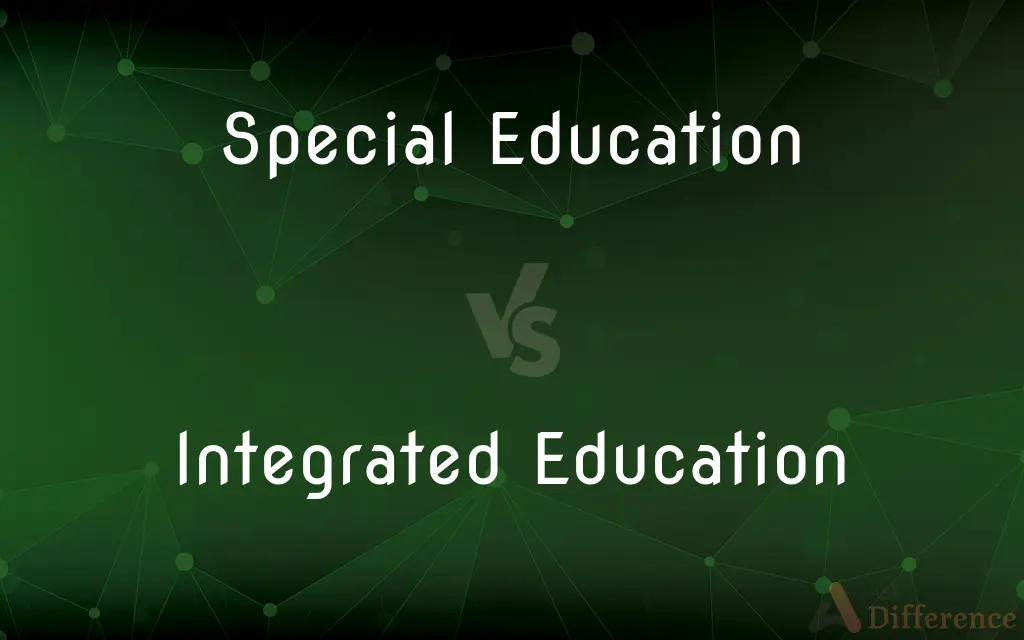Special Education vs. Integrated Education — What's the Difference?
By Tayyaba Rehman — Published on January 29, 2024
Special Education focuses on tailored educational approaches for individuals with specific needs, while Integrated Education blends students with and without special needs in a common learning environment.

Difference Between Special Education and Integrated Education
Table of Contents
ADVERTISEMENT
Key Differences
Special Education is a tailored instructional method designed for students with unique learning needs, distinct from traditional academic approaches. Integrated Education, in contrast, involves educating students with and without special needs in the same environment, aiming for inclusivity and collective learning experiences.
In Special Education, the curriculum and teaching methods are often customized to address the specific challenges and abilities of each student. Integrated Education, however, promotes an inclusive setting where students of all abilities learn together, with the curriculum and teaching methods being designed to cater to a diverse student body.
The goal of Special Education is to provide a supportive and adapted learning environment to students who may not thrive in a conventional classroom setting. Conversely, Integrated Education focuses on removing barriers to learning by integrating students with special needs into regular classrooms, fostering a sense of community and understanding among all students.
Special Education often requires specially trained educators who are skilled in addressing the unique needs of their students. In Integrated Education, teachers are typically trained to manage a diverse classroom, employing strategies that benefit both students with special needs and their peers.
Special Education programs are generally designed with a focus on individual student progress and may involve one-on-one instruction or small group settings. Integrated Education, on the other hand, emphasizes collaborative learning and social interaction among students with varying abilities, often within larger classroom settings.
ADVERTISEMENT
Comparison Chart
Focus
Individualized learning needs
Inclusivity and diversity in learning
Setting
Separate classes or schools
Common classrooms with all students
Teaching Methods
Customized to individual needs
Adapted for a diverse student group
Teacher Training
Specialized in specific needs
Trained for inclusive education
Student Interaction
Limited to similar peers
Diverse, with peers of all abilities
Compare with Definitions
Special Education
Special Education is teaching tailored for students with unique learning challenges.
The new Special Education program at school has significantly helped Emma with her dyslexia.
Integrated Education
Integrated Education combines students with and without special needs in the same classroom.
Integrated Education at our school promotes empathy and understanding among all students.
Special Education
Special Education encompasses educational adjustments for those with learning differences.
Special Education in our school includes modified assignments for students with ADHD.
Integrated Education
Integrated Education is the practice of teaching students of all abilities together.
Integrated Education has been key in fostering a sense of community in our school.
Special Education
Special Education is a service provided to students with specific learning needs.
Mia's progress in math has improved thanks to the Special Education services she receives.
Integrated Education
Integrated Education is an inclusive approach to teaching diverse learners together.
The Integrated Education model in Sara's class has enhanced her social skills.
Special Education
Special Education refers to specialized teaching methods for students with disabilities.
The Special Education teacher uses different techniques to help students with autism learn effectively.
Integrated Education
Integrated Education involves blending special and general education in a unified setting.
In their Integrated Education program, children with different abilities learn from each other.
Special Education
Special Education involves customized educational plans for those with disabilities.
John's Special Education plan includes speech therapy and additional reading support.
Integrated Education
Integrated Education focuses on educating all students in an inclusive environment.
Integrated Education helps reduce stigma by teaching students with varying needs side by side.
Common Curiosities
What is the main goal of Special Education?
To provide individualized learning support to students with unique needs.
Can Integrated Education improve academic outcomes for students with special needs?
Yes, it can promote better academic and social outcomes.
What is the teacher's role in Integrated Education?
To facilitate an inclusive and supportive learning environment for all students.
How does Integrated Education impact students without special needs?
It fosters empathy, social skills, and an understanding of diversity.
What are the key elements of a Special Education program?
Individualized Education Plans (IEPs), specialized teaching methods, and support services.
How does Integrated Education promote inclusivity?
By educating students of all abilities together, reducing segregation and stigma.
How does Integrated Education differ from regular education?
It integrates students with and without special needs in the same learning environment.
Who can benefit from Special Education?
Students with disabilities, learning challenges, or special needs.
Can students in Special Education participate in general education classes?
Yes, many participate in general education classes with appropriate support.
Is Special Education only for students with severe disabilities?
No, it's for any student with learning challenges or special needs.
Does Integrated Education require special training for teachers?
Yes, teachers usually receive training in inclusive teaching strategies.
Are Special Education programs the same in all schools?
No, they vary based on individual student needs and school resources.
What are the challenges of Integrated Education?
Balancing diverse needs, ensuring adequate resources, and training teachers.
Do parents play a role in Special Education planning?
Yes, parents are often involved in developing and reviewing IEPs.
Are there assessments specific to Special Education?
Yes, assessments in Special Education are tailored to measure individual student progress.
Share Your Discovery

Previous Comparison
Brisket vs. Pot Roast
Next Comparison
AJAX vs. FetchAuthor Spotlight
Written by
Tayyaba RehmanTayyaba Rehman is a distinguished writer, currently serving as a primary contributor to askdifference.com. As a researcher in semantics and etymology, Tayyaba's passion for the complexity of languages and their distinctions has found a perfect home on the platform. Tayyaba delves into the intricacies of language, distinguishing between commonly confused words and phrases, thereby providing clarity for readers worldwide.
















































